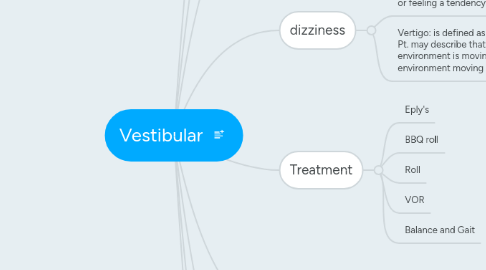Vestibular
von Jonathan Gonzalez


1. Interventions
1.1. BPPV
1.1.1. CRM
1.1.1.1. BBQ
1.1.1.1.1. Liberatory sermont
1.2. Hypofuncitons
1.2.1. Gaze stability exercises
1.2.2. Vestibular adaptation
1.2.2.1. x1
1.2.2.1.1. x2
1.2.3. Postural stability
1.2.4. Habituation
1.2.5. Pool therapy
1.2.6. Tai chi
1.2.7. Balance exercises
2. Balance
2.1. is the ability to control the center of gravity overt the base of support in a given sensory environment
3. Discerning Peripheral Vestibular Pathology from Central Vestibular Pathology
3.1. nystagmus
3.2. Recovery time
3.3. vertigo intensity
3.4. tilt of pts SVV
3.5. ocular tilt reaction (OTR)
3.6. Diplopia time
4. dizziness
4.1. is vaguely defined asthe sensation of whirling or feeling a tendency to fall
4.2. Vertigo: is defined as an illusion of movement. Pt. may describe that they sense their environment is moving or that they see the environment moving (spinning
5. Treatment
5.1. Eply's
5.2. BBQ roll
5.3. Roll
5.4. VOR
5.5. Balance and Gait
6. Vestibular system dysfunction
6.1. Peripheral pathology
6.1.1. BPPV
6.2. Decreased receptor input
6.2.1. UVH & BVH
6.3. Central nervous system pathology
6.3.1. CVA
6.3.1.1. PICA, AICA, VBI, Vertebral a.
6.3.1.2. Multiple sclerosis
7. Test and measures
7.1. VAS
7.2. DHI
7.3. VABQ
7.4. MSQ
8. Examination of eye movemnts
8.1. Examination for eye movement
8.2. Head impulse test
8.3. Head shaking nystagmus test
8.4. Positional testing
8.4.1. Dix-Hallpike test
8.4.2. Roll test
8.5. Dynamic visual acuity teset
9. Vestibular function test
9.1. SCC test
9.1.1. ENG,VNG
9.1.2. Rotational chair test
9.1.3. Caloric test
